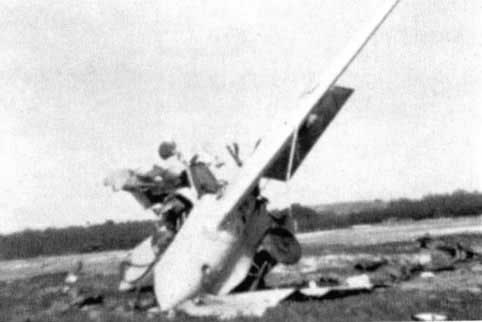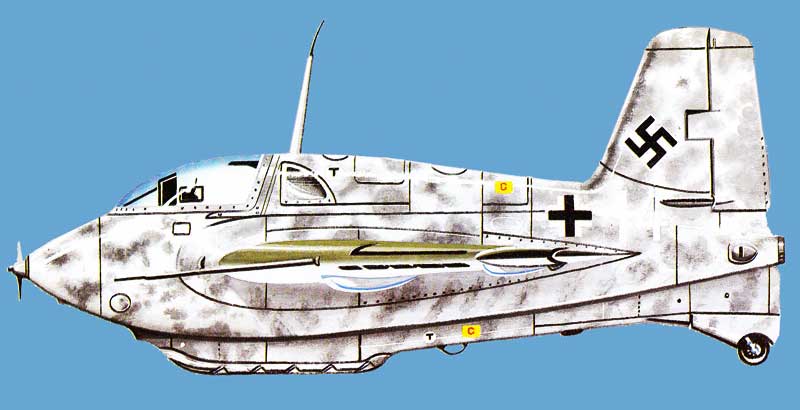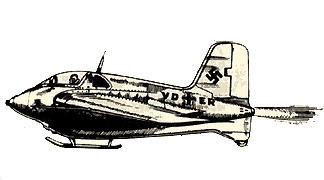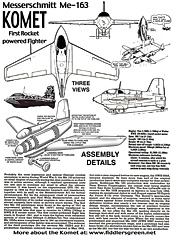

Messerschmitt Me-163 Komet - $$5.95
Operations began in 1944. As expected, the aircraft was extremely fast, and for a time the Allied fighters were at a complete loss as what to do about it. Singly or in pairs, the Komets attacked, often faster than the opposing fighters could dive in an attempt to intercept them.
Messerschmitt ME-163 Komet Rocket
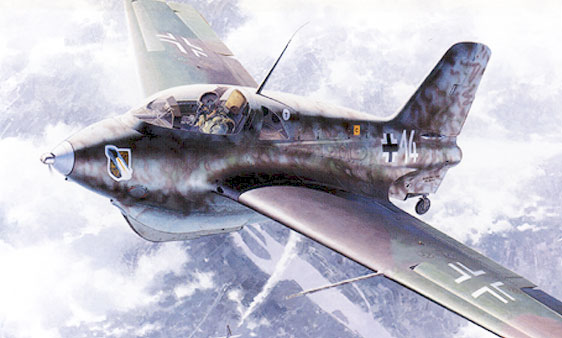
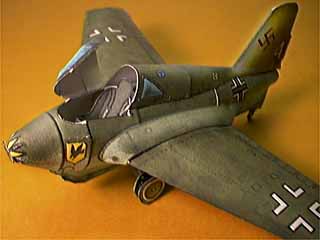
The Messerschmitt Me 163 Komet was the world's first (and so far only) operational rocket-powered fighter. Although the prototype Me 163A first flew in August 1941, it was not until February 1944 that production Me 163Bs entered service in any number, official disinterest playing a part in the slow progress of development. Although its performance was fantastic, the Komet carried only enough fuel for four minutes powered flying. The fuel was an extremely volatile cocktail mixed in flight, which would in the wrong proportions readily explode. Destruction of the fuel plant by bombing added to the Me 163 squadrons' woes in the last months of the war. Each mission, however, saw the available aircraft and pilot numbers reduced by fighters, off-field landings and landing crashes.
The operational Komets were based at Brandis, near Leipzig, and their primary task was to defend the oil refineries at Leuna, 55 miles to the south-west. The original, and much more sensible, plan had envisaged basing flights of Komets on the Allied bombers' approach routes into Germany; concentrating them at Leuna meant that they used up much of their fuel just getting as far as the target area.
Me163 looks good not as easy as Me262 I had problems thinking
that the canopy and spine should cover white area but I suspect
it should be
wider than white area ? where does the tail wheel go ? I think
that the wing fillets on the next one will be glued at their trailing
edge before
being put over the wing , that way the joint will be perfect as
one of mine isn't. I used the tissue in the nose trick and when
I had it assembled realized it was well balanced for flying (
mine printed on 80gm paper ) I turned up the trailing edge of
both the wings and it glided the length over the lounge , over
15 ft !
(Paul Needham 12/29/01)
Messerschmitt ME-163
 The top secret ME-163 was built as a last chance defense mechanism
for Germany's failing war effort beginning service in late 1943
as the only production rocket interceptor ever made.
The top secret ME-163 was built as a last chance defense mechanism
for Germany's failing war effort beginning service in late 1943
as the only production rocket interceptor ever made.
This little wonder was capable of climbing to 40,000 feet in just three minutes but with the high probability of the darn thing exploding upon landing, it's strategic advantage to the Germans was somewhat doubtful.
We've designed THREE different models so, if you'd like, you can set up a little bevy of 'em. They're numbered differently and the coloring is slightly different as well. This is the first design of our up-and-coming 'Flying Wings' series.
The world's first operational rocket-propelled fighter began life before the war when Dr Alexander Lippisch was asked to design a tailless aircraft to be powered by a Walter R 1-203 882-lb thrust rocket. A wooden test aircraft was begun under the designation DFS 194, but construction of the metal fuselage, considered necessary for the highly reactive rocket fuel, proved beyond the institute's resources, so in January 1939 Lippisch's team joined Messerschmitt and the design became the Me 163.
Delays to the program resulted in the wooden DFS 194 being fitted with the rocket, and when flight trials produced speeds of up to 342 mph Messerschmitt was instructed to produce six Me 163A prototypes as a prelude to production Me l63Bs with much more powerful motors.
When fitted with a 1653-lb thrust R II-203b it was found that the maximum speed of the Me 163A, at over 528mph, was still restricted by the limited amount of fuel that could be carried in the diminutive airframe. Construction of the prototype and production Me 163B airframes proceeded, but the new engines were late.
It was July 1943 before the intended engine was installed in one of the prototypes, and May 1944 before the first production B-la Komet entered Luftwaffe service: by July 1944 only 16 were operational.
In any case, although escorting fighters had little chance of intercepting the rockets, except on their un powered return flight, the latter, attacking at over 559 mph, had hardly any more chance of getting in an effective burst from their slow-firing MK 108s.
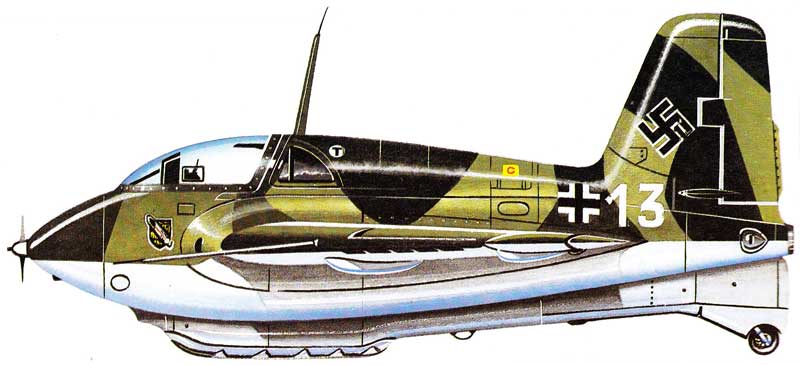
Some promise of success was offered by the Jagdfaust, a battery of 50-mm (1.97-in) shells fired automatically by an optical sensor reacting to a bomber's shadow, hut the war was over before it could be installed on a large scale. The introduction of an auxiliary combustion chamber for cruising flight on the prototype C-I was another promising line of development, but production was never begun.
The two-seat, un powered Me 163S trainer might also have reduced the number of accidents resulting from the heavy demands made on pilot skill by taking off from a jettisonable dolly and landing on a retractable skid, but the whole program had suffered too many delays for the Me 163 to become an effective weapon in the time available.
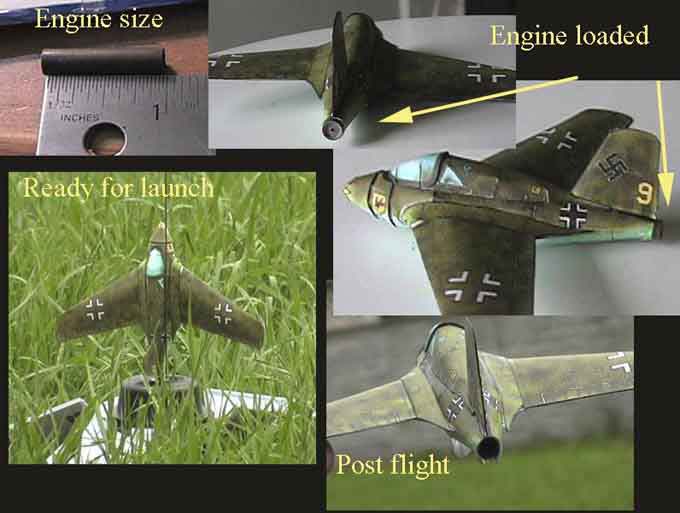 |
The easier way "My pal Dick and I stuffed a little bottle rocket
up into the nose of a mock up and it flew like a bat." |
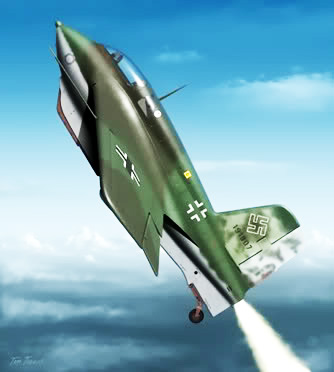
The Allies were astonished when they found out about the plans and new designs for rocket weaponry in an advanced stage of manufacture by the German technicians. A few of these weapons were actually used during the war, but most of them never got past the experimental stage. Nevertheless, they became useful prototypes for a good many of today's modern weapons.
The Komet, for example, shown above, was a revolutionary fighter that could fly at almost 1,000km/h. It carried two 30mm cannon and eight 5cm rocket-launchers above the wings or 24 below the wings. Fritz X, shown below, was a 1,500kg bomb. It was released by a bomber and was guided by radio to its target. One of these bombs sank the battleship Roma.
On the right is a picture of the Rheintochter ground-to-air missile. It was a two-stage rocket with a proximity fuse, and it never passed the experimental stage. The Germans were also at work on a gigantic missile to launch against the United States from Europe.
Probably the most ingenious and radical German combat aeroplane
to serve during World War 2, the Me 163 achieved no small degree
of success during the nine months or so that it was in active
service, although it reached operational units too late and in
numbers too small to affect the ultimate outcome. It was based
on the experimental DFS 194, designed in 1938 by Prof Alexander
Lippisch and transferred, together with its staff, to the Messerschmitt
AG for further development. But for the subsequent clash of personalities
between Lippisch and Prof Willy Messerschmitt, and the delay in
delivery of its rocket engines in later years, it would almost
certainly have been in service much earlier. 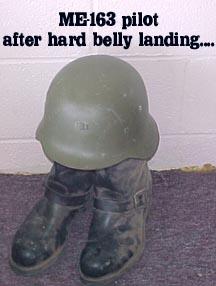
The first two Me 163 prototypes were flown in the spring of 1941 as un powered gliders, the Me 163V1 being transferred to Pee nem(indeed later that year to receive its 1,6531b St HWK IL!! rocket motor. The first rocket-powered flight was made in August 1941, and in trials the fighter soon exhibited speeds of more than 620mph . Ten un powered Me 163As were completed late in 1941 as conversion trainers, and development of the fighter was accelerated.
The airframe of the third prototype (for the seventy Me 163E-0 and B-I production machines ordered) was completed in May 1942, but over a year elapsed before its new engine, the HWK 509A, became available. By then more than half of the original production batch were also complete except for their powerplant's. Additional Me 163 production was undertaken by Hans Klemm Flugzeugbau, the overall total being slightly more than three hundred and fifty.
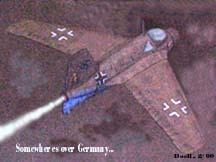 The first Luftwaffe unit to receive the Me 163B acquired its fighters
in June/July 1944, making its operational debut in mid-August
against US Eighth Air Force B-17s over Germany. The Komet's spectacular
speed, and the element of surprise, resulted in many early successes
against Allied bomber formations. However, the definitive version
was nearly a ton heavier than its original design weight, necessitating
the use of auxiliary booster rockets for take-off, while landings
were hazardous in the extreme.
The first Luftwaffe unit to receive the Me 163B acquired its fighters
in June/July 1944, making its operational debut in mid-August
against US Eighth Air Force B-17s over Germany. The Komet's spectacular
speed, and the element of surprise, resulted in many early successes
against Allied bomber formations. However, the definitive version
was nearly a ton heavier than its original design weight, necessitating
the use of auxiliary booster rockets for take-off, while landings
were hazardous in the extreme.
All too often the Me 163, landing directly on its fuselage keel-skid and with some of the highly inflammable fuel still left in the tank, would come to a literally comet-like end, with fatal results for its pilot. When the war ended the pressurized and improved Me 163C (HWK 5090 motor) had reached the pre-production stage, arid a prototype had also been flown of a derivative known first as the Me 163D and later as the Me 263, but this too was too late to go into production.
Thanks to Doc for the photo of the Komet
One place you can get fooled is gluing the keel to the bottom. Spread glue all around the inside edge of the keel and push firmly up onto the bottom of the fuselage using the tail fin for alignment. Hold till glue sets. The skid is basically optional but if you use it, fold the sides up and glue to the forward end of the keel.
Glue the upper fuselage on next with enough of a roll so as to not hide the fuselage markings. The cockpit goes on last along with the tiny generator prop on the nose. You can really do a job on this model by hinging the cockpit (I don't know, YOU figure it out), and putting in the seat.
|
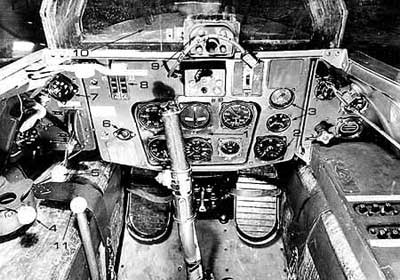 |
This image is of the Messerschmitt Me163 Cockpit. |
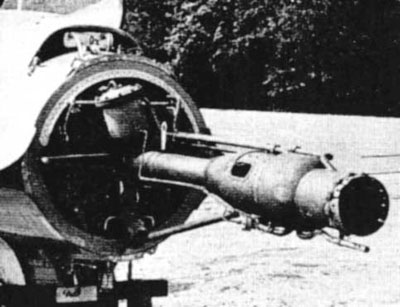 |
This image is of the Messerschmitt Me163 Rocket Motor. |
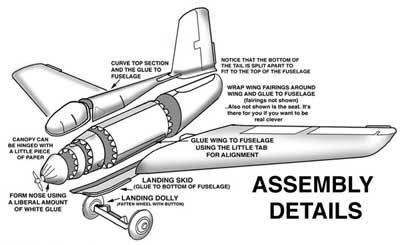
Specifications for the Messerschmitt Me-163 Komet
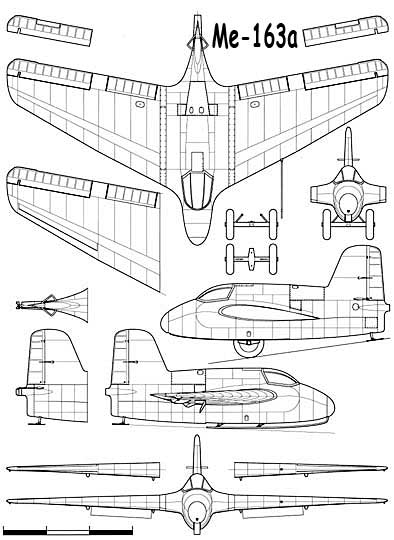 |
Span: 30ft 7in Performance Armament |
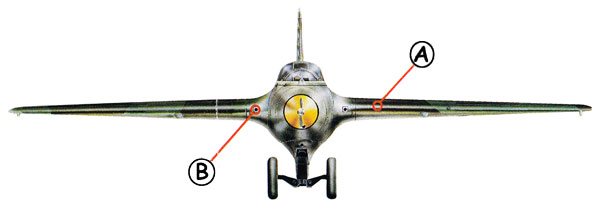 |
|
| A: The Komet handled superbly at speed, but at lower velocities had a tendency to "porpoise" or become unstable in pitch. | B: Although initially armed with a pair of 20-mm MG 151 cannon, the Me 163 was later given a pair of MK 103 30-mm weapons with 60 rounds per gun. |
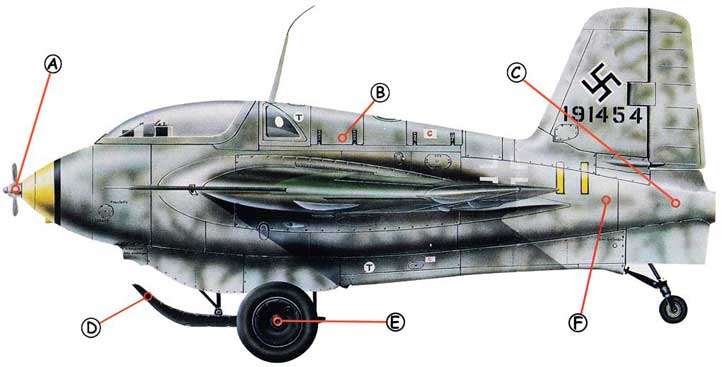 |
||
| A: A small air-driven propeller powered the Me 163's generator, providing electrical current for the aircraft's systems. | B: The Me 163 did not need much ground control. It could only intercept targets close to its base, so it had minimal radio equipment. | C: The Komet was powered by a single Hellmuth Walter Werke rocket motor and carried enough fuel for six minutes of full thrust. |
| D: The skid absorbed the landing forces. If a pilot forgot to extend it, the shock could cause injuries as serious as a broken back. | E: The wheels were jettisoned once the fighter was between 20 and 30 feet off the runway. Any lower and the pilot risked being hit as they bounced from the ground. | F: The Komet's tailless configuration was based on the work of aviation pioneer Dr. Alex Lippisch and offered considerable savings in weight and drag. |
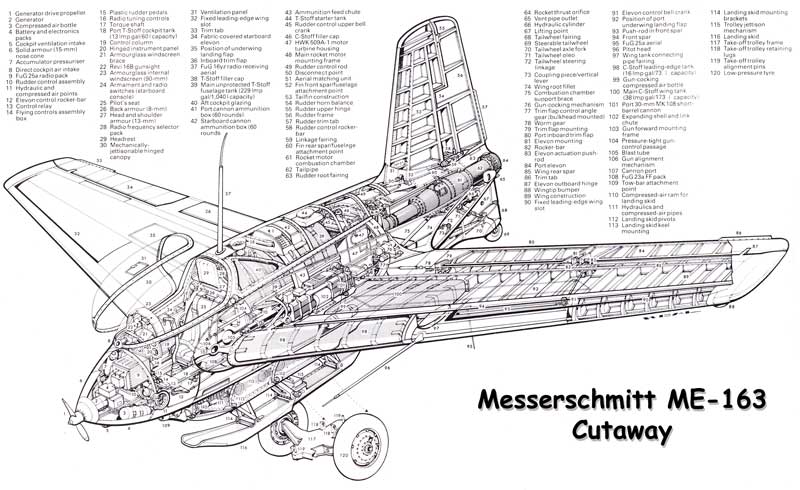 |
This beautiful ME-163 cutaway comes in full size 8.5 x 11 PDF for FREE included in your MyModels folder! |
